The chart below, from Figure 6 of Chris Quigg's paper hep-ph/0001145, shows "... Indirect determinations of the top-quark mass from fits to electroweak observables (open circles) and 95% confidence-level lower bounds on the top-quark mass inferred from direct searches in e + e annihilations (solid line) and in pbar-p collisions, assuming that standard decay modes dominate (broken line). An indirect lower bound, derived from the W-boson width inferred from pbar-p to (W or Z) + anything, is shown as the dot-dashed line. Direct measurements of mt by the CDF (triangles) and D0 (inverted triangles) Collaborations are shown at the time of initial evidence, discovery claim, and at the conclusion of Run 1. The world average from direct observations is shown as the crossed box. ...". I have added the blue line at 130 GeV, and the color of cyan for the region or Fermilab analysis of CDF and D0 events and the color of green for the region of my analysis of them:
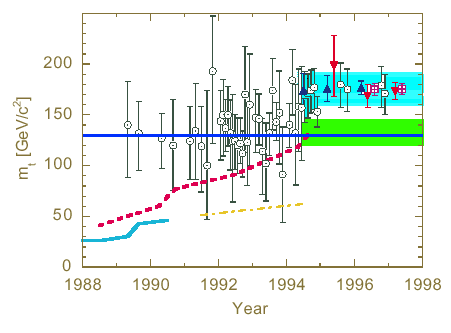
Note that around 1994, the time of the Fermilab/CDF claim that the Truth Quark mass was around 170 GeV, the Indirect determinations of the top-quark mass from fits to electroweak observables (open circles) rose from around 130 GeV to around 170 GeV.
For further details of the material represented by these charts, see:
During Run 1 of the Fermilab Tevatron Collider, CDF claimed discovery of the T-quark in FERMILAB-PUB-94/097-E, dated 26 April 1994:
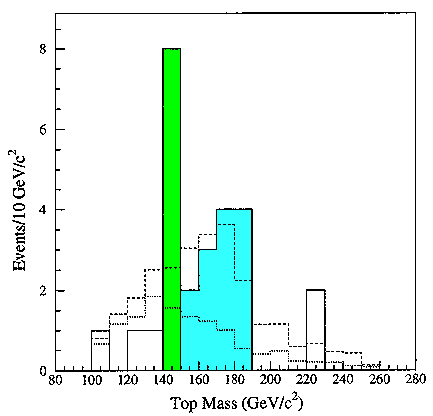
The green bars represent a bin in the 140-150 GeV range containing Semileptonic events considered by me to represent the Truth Quark, but as to which CDF said "... We assume the mass combinations in the 140 to 150 GeV/c^2 bin represent a statistical fluctuation since their width is narrower than expected for a top signal. ...",
and the blue bars represent bins in the 150-190 GeV range containing Semileptonic events interpreted as Truth Quarks by CDF, but considered by me to be poorly understood background.
In 1997, D0 similarly described events in hep-ex/9703008:
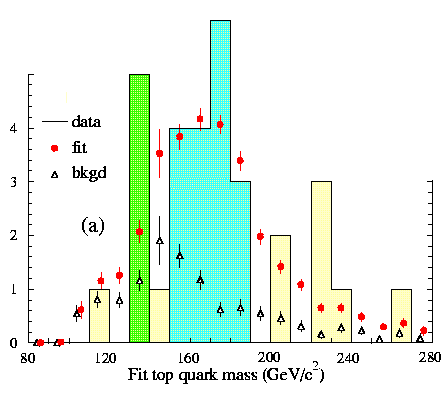
Similarly to the CDF histogram, the green bars represent a bin in the 130-140 GeV range containing Semileptonic events deemed insignificant by D0, but considered by me to represent the T-quark,
In my opinion:
with SEMILEPTONIC EVENT DATA variances from the DILEPTON MASS being used to study models of background and correct their deficiencies with respect to complicated electroweak and QCD phenomena,
and
with Tagged Semileptonic Events being better measures of Truth Quark Mass than untagged ones.
Details of the events, and the D0 analysis of the events, are in the 1997 UC Berkeley PhD thesis of Erich Ward Varnes. Here, from page 159 of the Varnes thesis, is a Truth quark mass likelihood plot for one of the 6 events, calculated by the neutrino weighting algorithm:
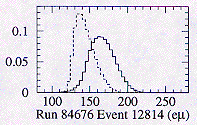
In this case, there were 3 jets instead of the 2 jets you would normally expect in a Dilepton event. The solid line is the plot if all 3 jets are included, and the dashed line is the plot if only 2 of the jets are included by excluding the third (lowest transverse energy) jet.
CDF analyzed of 9 of 11 Dilepton CDF events in February 1998,
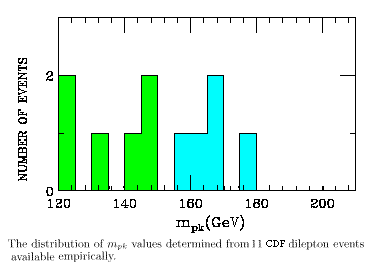
and in October 1998 CDF revised their analysis using 8 Dilepton CDF events:
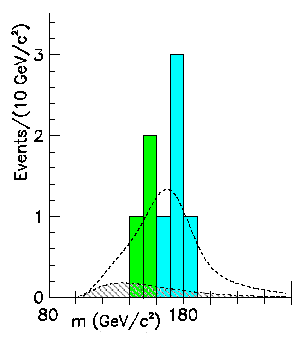
it appears to me that CDF has kept the 8 highest-mass dilepton events, thrown away the 3 lowest-mass dilepton events that were indicated to be in the 120-135 GeV range, and shifted the mass scale upward by about 10 GeV,
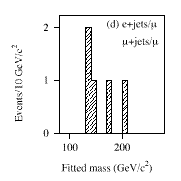
When event selection cuts were applied by D0 to the approximately 125 pb-1 of data from the 1992-1996 collider runs, 91 events were selected, 7 of which had a tag muon. After an additional cut based on Chi-squared less than 10, the 7 tagged events were reduced to the 5 shown on the histogram above (taken from Figure 25 of hep-ex/9801025). All 5 of those tagged events also passed the Low Bias selection cut applied by D0.
One event which would have otherwise passed the cuts, event (95653; 10822), was removed by D0 from its analysis because it was selected by the dilepton mass analysis. That event contained two electron candidates. However, one of the electrons just grazed the edge of the outer drift chamber, passing through the inner layers but not the outer ones. Thus, although there are hits in the inner layers, a complete track was not reconstructed. This event also contains a muon near one of its jets, consistent with b quark decay. If this event is treated as a l +jets candidate, it has a fit Chi-squared of 0.92 and fitted Truth Quark mass of 138.7 GeV (see footnote 10 of hep-ex/9801025).
Events per 10 GeV/c^2Reconstructed Mass (GeV/c^2)
D0 January 1996 mass reconstruction analysis of 5 Dilepton events gave a Truth Quark mass of about 145 GeV (+32,-32). CDF Dilepton event 45047/104393 has been analyzed by Dalitz and Goldstein, obtaining a Truth Quark mass of about 136 GeV (+18,-14). D0 and CDF have observed Semileptonic events in the 150-200 GeV range that they have interpreted as a Truth Quark of about 173 GeV. D0 and CDF have also observed Semileptonic events in the 130-150 GeV range, but D0 and CDF do not consider them sigificant. As the D4-D5-E6-E7-E8 model Truth Quark mass is in the 130-150 GeV range, it is consistent with Dilepton values, and with the Semileptonic events that have been considered insignificant by D0 and CDF.
My opinion is that:
SEMILEPTONIC EVENTS, even though there are more of them, involve BACKGROUND MODELS that use complicated calculations of electroweak and QCD processes that may not yet be fully understood, and so should NOT BE USED FOR PRIMARY DETERMINATION OF THE TRUTH QUARK MASS. The DILEPTON EVENT MASS should be considered PRIMARY INPUT.
In the following two histograms, the green bars represent bins in the 130-150 GeV range with the Semileptonic events deemed insignificant by D0 and CDF and the blue bars represent bins in the 150-190 GeV range with the Semileptonic events interpreted as Truth Quarks by D0 and CDF.
The first histogram is of CDF events described in 1994 in FERMILAB-PUB-94/097-E

The next histogram is of D0 events described in 1997 in hep-ex/9703008

HERA H1 has observed events above the 150 GeV energy range that were not predicted by standard DIS models. HERA ZEUS has observed fewer, but similar, events. Some have interpreted the HERA events as LeptoQuarks, but I think that the HERA events in the energy range above 150 GeV are the same phenomena that have been misidentified by CDF and D0 as semileptonic Truth Quark events in the 150-200 GeV energy range. The following histogram shows that the HERA H1 events begin to appear with unusual frequency at the 150-200 GeV energy range in which CDF and D0 report semileptonic Truth Quark events, which energy range is shown in blue:
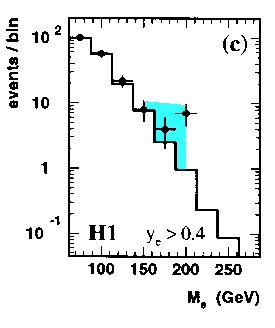
The next histogram compares the HERA H1 observed data with the 1-sigma deviation line from the standard NC DIS expected data, with the 150-200 GeV energy range shown in blue:
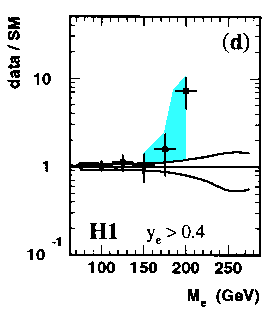
It is clear that the 150-200 GeV phenomena do exist, as the experimenters at Fermilab and DESY do very good work, and all 4 detectors, D0, CDF, H1, and ZEUS are seeing something in the same energy region, even though the number of events is small.
According to hep-ex/9910012 by the H1 and ZEUS Collaborations at HERA: "...Between mid-1994 and the end of 1997 the electron-proton collider HERA at DESY has been operated ... . In this period, ZEUS and H1 have collected e + p data samples corresponding to integrated luminosities of 47.7 pb^(-1) and 37 pb^(-1), respectively. In 1998 and the first half of 1999, each experiment has taken about 15 pb^(-1) of ... data ... The excess in the H1 data is still present at Me = 200 GeV but has not been corroborated by the 1997 data. Also ZEUS observes an excess at Mej > 200 GeV; however, the decay angular distribution does not support a LQ interpretation ...
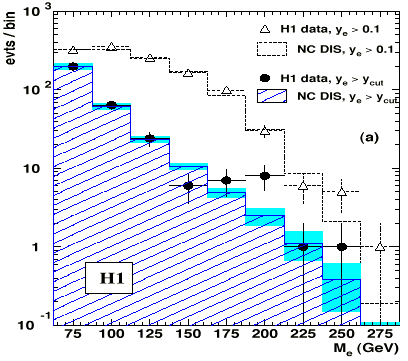
... The symbols with statistical error bars represent the data, the histograms the DIS MC. The H1 data are shown before (open triangles) and after (full dots, hatched histogram) a cut y>ymin(Me). The shaded area indicates the uncertainty of the SM prediction. ...".
"... A data sample corresponding to an integrated luminosity of 232 pb^(-1) was collected in 1997 and 1998 by the L3 experiment at LEP in e+ e- collisions at centre-of-mass energies between 181.7 GeV and 188.7 GeV. ...
... the cross sections for single W production ... [are compared in this figure] ...
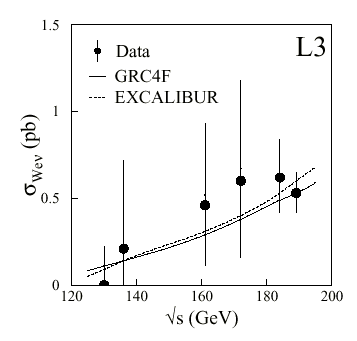
... to the SM predictions obtained with the EXCALIBUR and GRC4F MC [Monte Carlo] programs. ...
[The data in the region 160 GeV to 180 GeV seem to be substantially higher than the Monte Carlo predictions, indicating to me that the background in that region is incompletely understood.][In this figure,
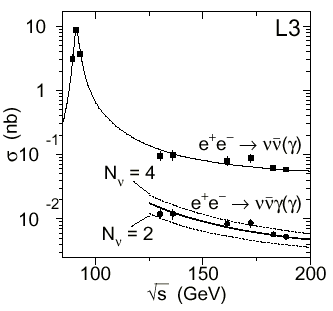
the data in the 175 GeV region is consistent with 4 generations of neutrinos, rather than 3, also indicating to me that processes in that region are incompletely understood.]
... [the following figure] presents the evolution of the WW cross section with sqrt(s) as measured by L3,
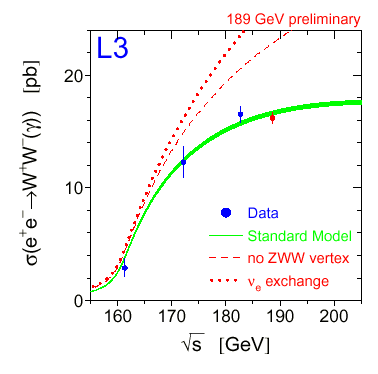
compared with the theory predictions. ...
[Again, the data in the region around 180 GeV seem to be substantially higher than the Standard Model predictions, indicating to me that the background in that region is incompletely understood.] ...".
If the 150-200 GeV phenomena are not Truth Quarks or LeptoQuarks, then what are they?
It is also possible that some of the phenomena may be due to the fact that a pair of charged W-bosons has mass of about 160 GeV, and a pair of neutral Z-bosons has mass of about 180 GeV, so that maybe something is going on with weak bosons in the 150-200 GeV energy range (perhaps involving Higgs scalars) that is not taken into account in the standard DIS models and background models with respect to which the 150-200 GeV phenomena have been identified. That might be consistent with the analysis of Bassler and Bernardi of the HERA events in which they conclude that the HERA data "... render unlikely an interpretation of the excess observed by [H1 and ZEUS] as originating from the decay of a single narrow resonance." What sort of W and Z interactions might omitted from those models? For one thing, HERA H1 says: "... It should be noted that inelastic single Z0 and W+- production is not contained in the standard DIS model ... and thus it is treated here as a background source. Especially contibutions from radiation of a Z0 or W+- from a quark can give rise to forward positrons and thus mimic NC DIS events at very high Q^2." For another, I note that HyperDiamond Feynman Checkerboard model, a discrete model similar to the continuum D4-D5-E6-E7-E8 model, predicts at tree level (quark masses are constituent masses): The tree level mass of a Higgs scalar, about 146 GeV, is somewhat higher than, but roughly similar to, the tree level Truth quark mass of about 130 GeV. In the D4-D5-E6-E7-E8 physics model, the sum of the tree level masses mW+ + mW- + mZ0 of the 3 weak bosons W+, W-, and Z0, that is, the physical weak bosons below the Higgs mass scale, is the fundamental energy level vacuum expectation value v of the Higgs scalar field. To give the tree-level particle masses mW+ = mW- = 80.326 GeV and mZ0 = 91.862 GeV (as well as the other calculated particle masses and force strength constants of the D4-D5-E6-E7-E8 model), P is set equal to 252.514 GeV. The D4-D5-E6-E7-E8 model assumed value v = about 80+80+92 = 252 GeV which is close to the tree level mass of the Truth quark T-T(bar) meson of about 260 GeV. Mw, the square root of the sum of the squares of the tree level masses of the 3 weak bosons W+, W-, and Z0, that is, the physical weak bosons below the Higgs mass scale, is 146.09298 GeV, which is very close to the mass of the tree level Higgs scalar mass of 145.789 GeV. The tree level mass of a pair of Higgs scalars, about 292 GeV, is somewhat higher than, but roughly similar to, the fundamental energy level vacuum expectation value v of the Higgs scalar field, about 252 GeV, and the Truth quark T-T(bar) meson mass of about 260 GeV.
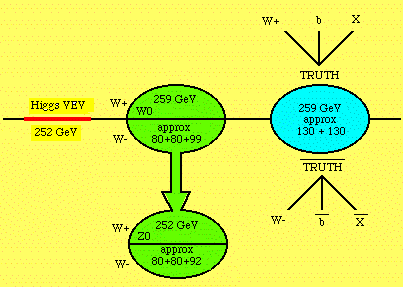
Each quark in the T-Tbar can decay very rapidly to W + b + X (where X is just an indication for other miscellaneous stuff).
The first paper I ever put on the Los Alamos e-print archive, Calculation of 130 GeV Mass for T-Quark, was at MENTOR.LANL.GOV for years:
A few people, including me, who like the concepts of Truth and Beauty, still call the T-Quark the Truth Quark instead of the Top Quark. I also call it Truth Ceng Zi, because Ceng Zi means quark in the language of the physicist who first proposed it.
The D4-D5-E6-E7-E8 VoDou Physics model, which predicts a Truth Quark mass of about 130 GeV, describes our 4-dimensional Physical SpaceTime; 4-dimensional Internal Symmetry Space; SU(3)xSU(2)xU(1) Gauge Bosons, Gravity, the Higgs Mechanism, and Complex Propagator Phase; 3 Generations of Musaka/Ganesha Fundamental Elementary Fermion Particles.
The Musaka/Ganesha Particles are NOT the Physical Electrons, Neutrinos, and Quarks, but are the Musaka/Ganesha Virtual Sea and Valence Particles in the Gaja/Ganesha Compton Vortices that are the Physical Electrons, Neutrinos, and Quarks.
Click Here to see motivation for the terminology Musaka, Gaja, and Ganesha.
Click Here to see my view of the relationships among Musaka/Ganesha Fundamental Elementary Particles, Gaja/Ganesha Physical Compton Vortex Elementary Particles, Near Field Gaja/Ganesha Compton Vortex Phenomena, and Far Field Gaja/Ganesha Compton Vortex Phenomena.
Click Here to see hep-ex/9809011, an analysis of the T-Quark data at CDF and D0 from Fermilab's official point of view. Fermilab's view is that Mt = 173.8 +/- 5.0 GeV, as opposed to my view of about 130 GeV. The paper hep-ex/9809011 is a review article, substantially summarizing the data and analyses of earlier papers. The data and analyses are discussed in more detail in the rest of this web page, and the pages to which it is linked.
......